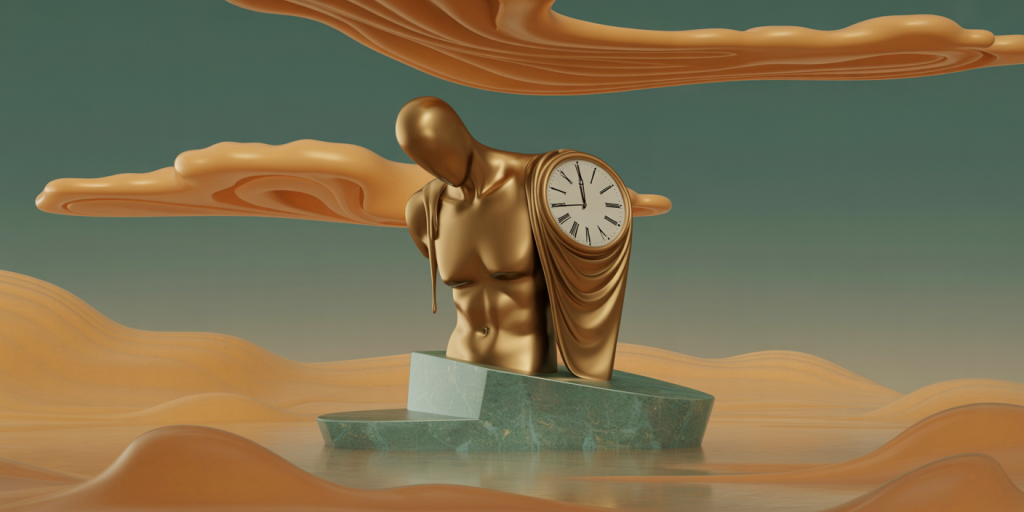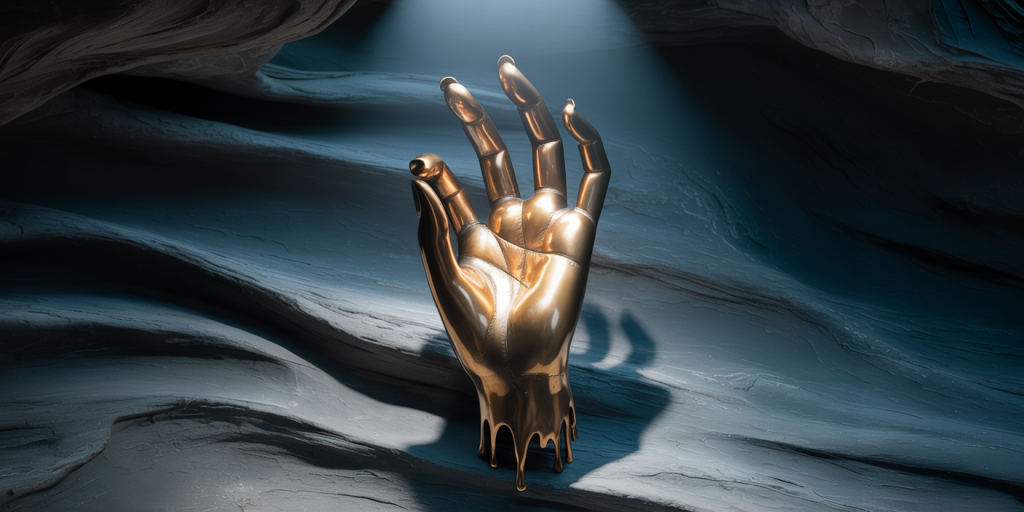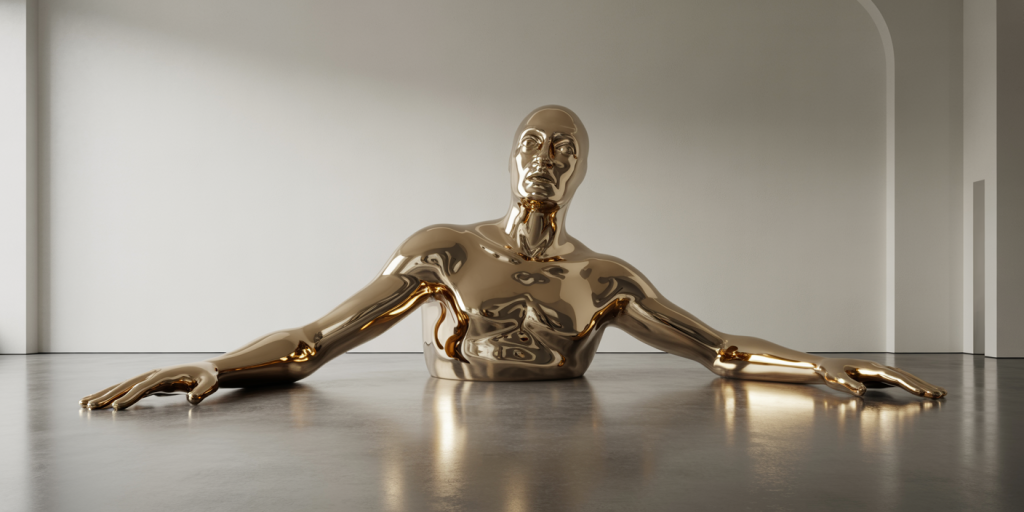The Body Melts in Space: Dalí and Bronze in Suspension
A Breath of Bronze and Dream
There are moments in which the body ceases to obey the laws of gravity. Not in defiance, but in surrender. In Salvador Dalí’s surreal bronze sculptures, the flesh loosens its contract with time, and form unfastens from logic. The result is a world suspended between delusion and devotion, where human limbs stretch like honey and time folds like silk. Bronze, usually a medium of strength and solidity, becomes a fluid matter in Dalí’s vision—capable of melting, dreaming, dissolving.
To walk around one of Dalí’s bronze figures is to feel as though you are circling an unanswered question. What is a body when its outline is undecided? What is mass when its center is a hole? These sculptures do not speak; they whisper in riddles. They invite your fingers to trace the edge of impossibility, to touch a surface that remembers dreams more than anatomy.
Table of Contents
- Flesh That Dreams in Bronze
- Clocks That Weep Through the Ribcage
- The Mustache of the Eternal Observer
- Spines Suspended in Time
- When Limbs Begin to Float
- Echoes of a Melting Deity
- Crutches, Crosses, and the Architecture of Fragility
- Eyes That Refuse to Close
- Wings of Wax Cast in Metal
- Desire with a Skeletal Face
- The Bronze That Breathes Absurdity
- Shadows Folded into Form
- The Dalíian Void
- Hands Holding Empty Skies
- Fear as Ornament
- Erotic Gravitation
- Tactile Delirium
- Bodies Without Beginning or End
- Sculpting a Dream That Won’t Wake
- Bronze Echoes of a Liquid Self
Flesh That Dreams in Bronze
In Dalí’s bronze sculptures, flesh becomes an idea rather than a structure. These are not bodies born of biology, but of memory, hallucination, and longing. They stretch in implausible directions, thinning where they should thicken, and dripping where they should hold. In this imagined musculature, we find psychological truths.
Bronze—a material often associated with heroic permanence—is here rendered pliable. Dalí manipulates its density, fooling the eye into believing the medium is wax or molten amber. The tension between weight and drift is central. These bodies seem to float, yet they are firmly cast. This paradox is where the surreal lives.
Clocks That Weep Through the Ribcage
Nowhere is Dalí’s symbolic mastery more evident than in his melting clocks. Draped across torsos or bleeding from hips, they are not merely timepieces. They are organs, visible metaphors for the slow erosion of order.
Placed across human anatomy, they distort not just time, but identity. The clock becomes a parasite, a lover, a wound. In their softness, they deny the authority of chronology. They mourn the idea of precision, melting instead into memory and skin.

The Mustache of the Eternal Observer
Dalí’s famous mustache—a symbol of his cultivated persona—sometimes appears subtly encoded in his sculptures. It surfaces as curve, as flourish, as whimsical antenna.
It represents more than self-portraiture. It is the mark of the observer, the surrealist sentinel watching from the margins of madness. In this signature, Dalí remains present, not as man, but as myth.
Spines Suspended in Time
The backbone in many of Dalí’s forms is distorted, exaggerated, curved like a serpent caught mid-sway. It functions not just as anatomical reference, but as metaphor for fragility suspended in the act of endurance.
These spines ripple like sound waves, hinting at movement even in stillness. They suggest the burden of memory, the vertebrae of dreams stacked against a sky that never solidifies.
When Limbs Begin to Float
In the realm of Dalí, arms and legs detach themselves from the logic of locomotion. They extend, drift, and orbit around the core like satellites of longing.
This fragmentation is not violent but poetic. The limbs are in migration. They seek something—perhaps reunion, perhaps transcendence. They float not away from the body, but deeper into it.
Echoes of a Melting Deity
Dalí’s figures often take on divine proportions—not in size, but in aura. They resemble deities caught mid-transformation, in the fevered act of unbecoming.
Melting is not death here; it is revelation. These sculptures reveal the instability of form as a sacred truth. The divine is not fixed but fluid, and holiness leaks.
Crutches, Crosses, and the Architecture of Fragility
Few symbols reappear with as much quiet intensity in Dalí’s work as the crutch. Propping up torsos, balancing thoughts, leaning into voids, they are not tools of mobility but relics of support.
They suggest that belief itself needs scaffolding. They evoke faith as something tenuous, held aloft by borrowed strength. The body does not stand alone—it leans into metaphor.
Eyes That Refuse to Close
Even when uncarved, the presence of eyes haunts these sculptures. The gaze is diffused through posture, gesture, even negative space.
There is a watchfulness in the tilt of a headless neck, in the direction of a curved arm. The sculptures see without optics. They perceive without pupils. Their awareness is omnidirectional.
Wings of Wax Cast in Metal
Occasionally, Dalí gifts his beings with wings—not functional, but philosophical. These are wings dreamed in childhood and cast in maturity.
They are heavy, impractical, and deeply human. They symbolize the yearning for ascent even as the body melts downward. They are contradictions sculpted in bronze.
Desire with a Skeletal Face
There is eroticism in Dalí’s forms, but it is not fleshly. It is anatomical. Bones flirt. Tendons seduce. Ribs invite.
Desire here is not about pleasure but about pursuit. It is the ache that remains when the object dissolves. It is hunger given form.
The Bronze That Breathes Absurdity
Dalí does not sculpt conclusions. He sculpts questions. His bronze is not a testament to form, but to its failure.
Absurdity is not a flaw, but a medium. In every drip, every droop, every hole, there is a wink from the dreamer who dared to cast dreams.
Shadows Folded into Form
Light is not an afterthought in these sculptures. It is a participant. The folds and crevices invite darkness like a second skin.
As the sun moves, so do the meanings. A highlight becomes a tear. A shadow becomes a whisper. The sculptures change with the hour, breathing shadow.
The Dalíian Void
Many of Dalí’s sculptures are defined not by what they include, but by what they omit. Cavities take center stage. Absence becomes structure.
These voids are not empty. They are thick with silence. They hum with omission. They hold the shape of vanished thoughts.
Hands Holding Empty Skies
Dalí’s hands are not instruments; they are relics. They reach upwards, not to grasp, but to offer.
Their palms are open, their fingers elongated. They seem to hold nothing—and in that nothing, they cradle the weight of surrender.

Fear as Ornament
The grotesque in Dalí’s sculptures is not accidental. It is decorative. Horns, scars, hollow eyes—these are embellishments of dread.
Fear becomes aesthetic. The body wears it like jewelry. It is not hidden. It is honored, cast, polished.
Erotic Gravitation
Two forms lean toward each other. Their limbs do not touch, but the space between them throbs. This is gravity as eros.
The attraction is not physical but philosophical. They are drawn by the void between them. Desire is the force that bends their forms.
Tactile Delirium
Touch these sculptures and you do not feel bronze. You feel fever. Texture in Dalí is a trance. Surfaces shimmer with suggestion.
Every bump is a memory. Every smooth patch is a sigh. The hand wanders, unsure if it touches or is being touched.
Bodies Without Beginning or End
Dalí’s figures often defy anatomical sequence. A foot emerges from a shoulder. A mouth yawns from a thigh. Continuity is broken.
These are not malformed beings. They are poems without punctuation. They begin again with every gaze.
Sculpting a Dream That Won’t Wake
Every Dalí sculpture feels caught in the moment before awakening. It resists coherence. It delights in disorientation.
It is the body dreaming of itself, melting into the symbols it once wore. It is the bronze of a mind refusing clarity.

Bronze Echoes of a Liquid Self
Dalí’s sculptures are not illustrations. They are echoes. They vibrate with the memory of a self that never quite existed, but always haunted the skin.
In them, we see not the body as it is, but as it feels. Melted, suspended, eternal.
FAQ
Q: Who was Salvador Dalí?
A: A Spanish surrealist artist known for his dreamlike imagery, Dalí worked across painting, film, and sculpture. He was born in 1904 and died in 1989.
Q: Did Dalí create bronze sculptures himself?
A: He conceptualized them and collaborated with foundries to cast his surreal visions, particularly in the latter half of his career.
Q: What is the meaning of the melting clocks?
A: They symbolize the fluidity of time and the erosion of structure in the subconscious mind.
Q: Why does Dalí use crutches in his sculptures?
A: Crutches symbolize psychological and spiritual support. They reflect the fragility of belief and identity.
Q: How is texture used in Dalí’s bronzes?
A: Texture creates tactile contrast, evoking both sensuality and distortion. It enhances the surreal quality of each piece.
Final Reflections: The Gravity of Illusion
Dalí’s bronze sculptures defy the very medium they occupy. They are not frozen moments but ongoing dissolutions. In their curves, holes, and elongations, they whisper that form is illusion, and illusion is sacred.
To view these sculptures is to lose footing in reality—and discover, in suspension, a truth more durable than stone.
